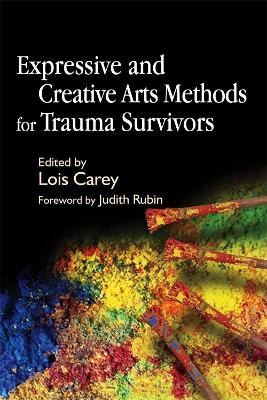
Expressive and Creative Arts Methods for Trauma Survivors
Jessica Kingsley Publishers (Verlag)
978-1-84310-386-8 (ISBN)
With the increasing probability of floods, wars, and human displacement, there will be a great need for health care professionals to help. The arts provide a new, human, and cost-effective way to bring relief and to ease some of the human suffering associated with trauma.The editor, Lois Carey, presents a compelling rationale for the use of the arts therapies to work with trauma. First, it is now clear that traumatized children have difficulty using words to describe their experience. Drawing, play, music and other creative forms allow for an indirect expression that reduces anxiety, and they also help to establish a therapeutic relationship and an area of safety. The same is true for traumatized adults, who are often nonverbal... this book can be a beginning of much-needed documentation of the use of the expressive arts methods for trauma survivors and will provide a significant and useful introduction to the field for health professionals.'
- PsycCRITIQUES
'I think the descriptions of the methods are interesting and they show a lot of experience in the field of trauma-treatment. It is a well written, very readable book of the practice.'
-Tijdschrift voor Vaktherapie (Journal of Therapy)
'This book throws more light on different expressive and creative arts methods in the treatment of trauma. In detailed case studies and research, the authors offer an overview of creative arts methods aiming at brain functions which are not always being reached by verbal therapy alone.'
-Tijdschrift voor Vaktherapie (Journal of Therapy)
'The authors use a rich mix of interesting case material and useful explanation of the techniques for the uninitiated.'
- Therapy Today
'A very good job of promoting the use of expressive arts therapy to complement talking therapies and achieve results that talking therapy cannot.'
- Play Therapy UK
'If you are a parent, dealing daily with the effects of traumatised children, and especially finding it difficult to firstly access specialist therapy and secondly to understand the principles in relation to your child, then this book will give you a clear understanding of the aims and outcomes of therapies which may be on offer.'
- www.adoption-net.co.uk
Expressive and Creative Arts Methods for Trauma Survivors demonstrates how play, art, and music therapies, as well as sandplay, psychodrama and storytelling, can be used to aid the recovery of trauma victims.
Drawing on detailed case studies and a growing body of evidence of the benefits of non-verbal therapies, the contributors-all leading practitioners in their fields-provide an overview of creative therapies that tap into sensate aspects of the brain not always reached by verbal therapy alone. Methods of exploring traumatic experiences with a view to limiting patients' distress are also explored. The techniques discussed are appropriate for work with children, families and groups and are based on established approaches, including Jungian, Child-centred, Gestalt and Freudian theories.
Expressive and Creative Arts Methods for Trauma Survivors will be an enlightening read for expressive and specialized arts therapists and for students and academics in these fields.
Lois Carey lives in New York, where she has been a practicing therapist since 1978 and is Adjunct Professor of Play Therapy at Hofstra University. She is President of the New York branch of the Association for Play Therapy and offers Sandplay training under the aegis of the Center for Sandplay. She has published several articles in journals such as Arts in Psychotherapy and Play Therapy International and has authored three other titles on creative therapies: Family Play Therapy; Sandplay Therapy with Children and Families; and School-Based Play Therapy.
Acknowledgements. Foreword by Judith Rubin. Introduction - Lois Carey. 1. Neuroscience and Trauma Treatment: Implications for Creative Arts Therapists - David Crenshaw. 2. Crisis Intervention Play Therapy to Help Traumatized Children - Nancy Boyd Webb. 3. Working Toward Aesthetic Distance: Drama Therapy for Adult Victims of Trauma - Judith Glass. 4. An Expressive Arts Therapy Model with Groups for Post-Traumatic Stress Disorder - Susan Hansen. 5. Peter: A Study of Cumulative Trauma: From "Robot" to "Regular Guy" - Eleanor Irwin. 6. Art Therapy with Traumatized Families - P. Gussie Klorer. 7. Songs of the Self: Vocal Psychotherapy for Adults Traumatized as Children - Diane Austin. 8. Sandplay Therapy with a Traumatized Boy - Lois Carey. 9. Sandplay Therapy and the Body in Trauma Recovery - Dennis McCarthy. 10. Puppetry Interventions for Traumatized Clients - Diane Frey. 11. Video Play Therapy - Diane Frey. 12. The Bowl of Light: A Story-Craft for Healing - Joyce Mills. Conclusion - Lois Carey. List of contributors. Index.
| Verlagsort | London |
|---|---|
| Sprache | englisch |
| Maße | 157 x 218 mm |
| Gewicht | 352 g |
| Themenwelt | Medizin / Pharmazie ► Medizinische Fachgebiete ► Notfallmedizin |
| Medizin / Pharmazie ► Physiotherapie / Ergotherapie ► Ergotherapie | |
| ISBN-10 | 1-84310-386-9 / 1843103869 |
| ISBN-13 | 978-1-84310-386-8 / 9781843103868 |
| Zustand | Neuware |
| Haben Sie eine Frage zum Produkt? |
aus dem Bereich


